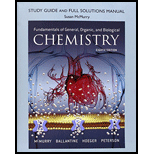
(a)
Interpretation:
The line structure of thiol should be drawn.
Concept Introduction:
Thiols:
The general structure of thiol is
The arrangement of the atoms is explained by the graphical representation of molecular structure of chemical compound.
(b)
Interpretation:
The disulfides should be drawn from the oxidation reaction of 2-pentanethiol.
Concept Introduction:
Thiols:
The general structure of thiol is
Oxidation of thiols:
Thiol undergoes oxidation using

Want to see the full answer?
Check out a sample textbook solution
Chapter 14 Solutions
Study Guide And Full Solutions Manual For Fundamentals Of General, Organic, And Biological Chemistry
- Ammonia, NH3, and phosphorus trihydride, PH3, both have trigonal pyramid geometry. Which one is more polar? Explain.arrow_forwardWhat characteristic must a compound have to experience the following intermolecular forces?arrow_forwardThreonine has two chiral centers. Draw L-threonine and indicate which carbon atoms are chiral. Which carbon atom is responsible for d and L configuration?arrow_forward
- One of these forms of cocaine is relatively insoluble inwater: which form, the free base or the hydrochloride?arrow_forwardWhat is the “octet rule” and its biologically important exception?arrow_forwardWhich of the following define the stereochemistry of alanine (as per the structure shown)? Note: Functional groups arranged horizontally are facing towards the front, and the functional groups arranged vertically are facing towards the back. a) d- b) S- c) R- d) I-arrow_forward
- How many of the carbons in the following structure are stereocenters?arrow_forwardWhat is the empirical formula for C3H6O3? C3H6O3 C6H12O6 CH2O None of thesearrow_forwardThe reaction of methoxy benzene with hydrogen iodide will yield a phenol and an alkyl halide. Which of following choices is the correct combination of the products?arrow_forward
- Glutathione, a powerful antioxidant that destroys harmful oxidizing agents in cells, is composed of glutamic acid, cysteine, and glycine, and has the following structure. a.) What product is formed when glutathione reacts with an oxidizing agent?b.) What is unusual about the peptide bond between glutamic acid and cysteine?arrow_forwardColumn A shows the names of some of the c functional groups. Column B shows their structure. Match each entry in column A one in column B.arrow_forwardPropanamide and methyl acetate have about the same molar mass, both are quite soluble in water, and yet the boiling point of propanamide is 486 K, whereas that of methyl acetate is 330 K. Explain.arrow_forward
